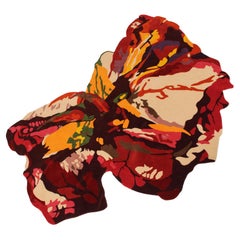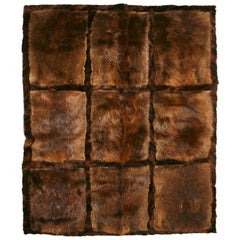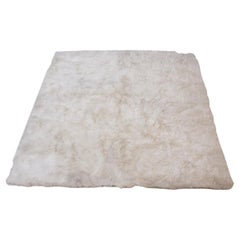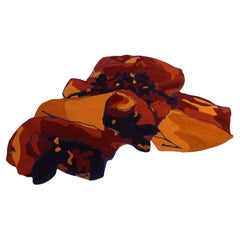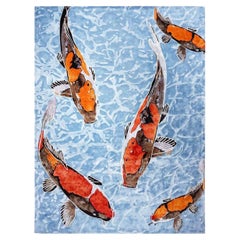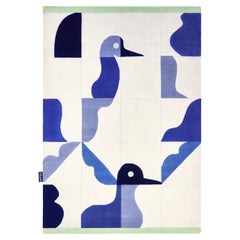LA Studio Rugs and Carpets
5
1
to
6
6
6
6
5
1
5
1
Width
to
Length
to
5
4
1
1
1
3
3
3
2
1
Leo Rydell Jost Contemporary Nepal Wool Handmade Carpet
By Leo Rydell Jost
Located in Madrid, ES
“Veggie Reap” model carpet designed by Leo Rydell Jost.
This carpet is part of "Botanic and Landscape" rugs collection.
Handmade of 100% Nepal wool. U...
Category
21st Century and Contemporary Nepalese Modern Western European Rugs
Materials
Wool
Hand-knotted Rug of the Botanica Collection by Leo Rydell Jost
By Leo Rydell Jost
Located in Madrid, ES
Unique hand-knotted rug of the Botanica Collection by Leo Rydell Jost.
Piece made in Tibetan wool in Nepal.
Rydell’s artwork balances between a visual ...
Category
2010s Nepalese Modern Indian Rugs
Materials
Wool
Western European Natural Otther Fur Rectangular Rug, France, 1970s
Located in Madrid, ES
Rectangular rug in natural otther fur. France, 1970s.
Every item LA Studio offers is checked by our team of 10 craftsmen in our in-house workshop. Special restoration or reupholster...
Category
Late 20th Century French Modern Western European Rugs
Materials
Fur, Fabric
Natural Sheep Hair Rug
Located in Madrid, ES
Natural sheep hair pile rug.
Measurements: 240 x 220 cm
Category
Early 2000s Western European Rugs
Materials
Natural Fiber
Hand-knotted Rug of the Botanica Collection by Leo Rydell Jost
By Leo Rydell Jost
Located in Ibiza, Spain
Unique hand-knotted rug of the Botanica Collection by Leo Rydell Jost.
Piece made in Tibetan wool in Nepal.
Rydell’s artwork balances between a visual approach and pleasurable home l...
Category
2010s Nepalese Modern Indian Rugs
Materials
Wool
Contemporary Modern Wool and Silk German Carpet
Located in Ibiza, Spain
Modern carpet with animal motifs. Handmade of wool and silk.
Our main target is customer satisfaction, so we include in the price for this item professional and custom made packin...
Category
2010s German Modern More Carpets
Materials
Wool, Silk
Related Items
Contemporary Kilim Rapallo Designed by Piotr Niklas / Hand-Woven
Located in WARSZAWA, 14
The RAPALLO kilim opens a series inspired by the Memphis Milano aesthetic, which defined the colorful design style of the 1980s and 90s. The designer. Piotr Niklas, in his own unique way, transformed the realizations of such designers as Ettore Sottsass and Nathalie du Pasquier into his individual language of forms. Piotr used a refreshed, pastel color palette.
The RAPALLO kilim is 100 x 190 cm, which makes it great for hanging it both vertically and horizontally. It works well as a decorative piece in the living room above the sofa, bed’s headboard, a background for a console or as a dominant decoration at the head of the table. A square meter of this fabric is a week’s worth of work of a professional weaver. The kilim was made in accordance with Bobowas traditions of weaving on a flax warp, while the weft is natural wool.
Kilim designed by Piotr Niklas - Graduate of the European Academy of Arts in Warsaw, he has been designing for over a decade. He specializes in visual identity, poster design, user interface and webpage design especially for cultural institutions, video game developers and tech companies. For his Kilim DAWN he received the MUST HAVE at the Lódz Design Festival.
Splot blends the finest tradition of Polish handcraft with modern and bold design.
The kilim has a long and fascinating tradition in Poland. They were initially brought from the East to the nobles’ manors, with time becoming more domestic and produced locally. They captivated Modernist artists, such as Stanislaw Wyspianski or Zofia Stryjenska, who often worked in this medium. In the 1920s and ’30s, kilims decorated grand public buildings as well as private Modernist villas. After the war, they were made in many of Cepelia's (Central Folk Art and Crafts Union) workshops, both for the Polish market as well as for export, unfortunately, with time this noble craft was nearly forgotten.
Kilims - stashed away in houses, stored in museums and attics, kindled my imagination.
In times of rapid mass production, time in itself has become a great luxury. It takes around a week to hand weave a square meter of a kilim. In this laborious process, we acquire a product that is unique in every respect - no two tapestries are alike, just as no two loaves of bread are the same. A kilim integrates art with nature. They are not only decorative but also practical, improving acoustics and warming the interior. Kilims are Polish, although they arrived here from far away. Traditional craftsmanship for the modern home.
Our dream of making modern Polish kilims...
Category
2010s Polish Post-Modern Tapestries
Materials
Wool
Free Shipping
H 39.38 in W 74.81 in D 0.4 in
Hand Knotted Birds Rug by Hatsu
Located in Geneve, CH
Hand knotted birds rug by Hatsu
Dimensions: D 140 x W 201 cm
Materials: Wool
Hatsu is a design studio based in Mumbai that creates modern l...
Category
2010s Indian Modern Indian Rugs
Materials
Wool
Hand Knotted Loop Rug by Hatsu
Located in Geneve, CH
Hand knotted loop rug by Hatsu
Dimensions: D 243 x W 243 cm
Materials: wool
Hatsu is a design studio based in Mumbai that creates modern lightin...
Category
2010s Indian Modern Indian Rugs
Materials
Wool
Hand Knotted Façade Rug by Hatsu
Located in Geneve, CH
Hand Knotted Façade rug by Hatsu
Dimensions: D 121 x W 198 cm
Materials: Wool
Hatsu is a design studio based in Mumbai that creates modern lighting that are unique and immediat...
Category
2010s Indian Modern Indian Rugs
Materials
Wool
cc-tapis After Party Natural White Rug by Garth Roberts
By Garth Roberts, cc-tapis
Located in Brooklyn, NY
Hand knotted in the cc-tapis atelier in Kathmandu, Nepal. The rug is made with a Himalayan wool and pure silk coming from the areas surrounding the atelier. 152.000 individual knots ...
Category
21st Century and Contemporary Nepalese Modern Western European Rugs
Materials
Metallic Thread
Antique French Tapestry Antique Tapestry Handmade Tapestry Verdure Tapestry
Located in New York, NY
Rare Antique French Tapestry handmade Verdure Tapestry
4' x 5'
122cm x 153cm
Circa 1920
A magnificent antique French tapestry depicting a hunting scene amongst a verdure s...
Category
Vintage 1920s French Tapestries
Materials
Wool
H 60.24 in W 48.04 in D 0.48 in
Antique French Tapestry Verdure Deer 3x6 Wool Foundation 92 x 172cm
Located in New York, NY
Antique French Tapestry Verdure Deer 3x6 3' x 5'8"
92cm x 172cm
k65101
About Us~
Welcome to Antique Rug Collection. Your #1 Source for handmade Antique Rugs & Tapestries at g...
Category
Vintage 1920s French Baroque Tapestries
Materials
Wool
Hand Knotted Hypnosis Rug by Spacewarp
Located in Mumbai, IN
A honeycomb of unknown depth. Octagonal, with the right balance of light and dark hues. Hypnosis is a contemporary rug for a space that needs a dash of color and elegance. Perfect fo...
Category
21st Century and Contemporary Indian Modern Indian Rugs
Materials
Wool
Ararat Rugs the Fintona William Morris Carpet, Arts and Crafts, Natural Dyed Rug
By Ararat Rugs
Located in Tokyo, JP
The source of the carpet comes from the book Arts & Crafts Carpets, by Malcolm Haslam, and David Black, 1991, fig.55. This Donegal carpet was possibly designed by the Silver Studio for Liberty’s c.1902, United Kingdom. In 1887 English artist and bookbinder T.J. Cobden Sanderson, suggested that a new group be named the “Arts and Crafts Exhibition Society” As a result, he was the first to use the term “Art and Crafts” and also is credited with naming this new emerging movement. The Arts & Crafts movement was inspired by the degradation of product standards that resulted from the factory production age. The rise of machinery in manufacturing caused a noticeable decline in uniqueness and crafts. These anti-industrial reformers promoted economic advancement and social change. They wanted to eliminate poor quality and “artificial” items from 19th-century British society. They saw a plethora of uninteresting items on display at the Great Exhibition of 1851 and became inspired to launch a campaign for originality and uniqueness.
William Morris was an English designer, as well as an uplifting social activist and writer. Morris is credited with sparking the rebirth of textile arts and traditional means of production. In 1861, Morris and a small group of designers opened an incredibly fashionable design company that grew to be largely successful. Morris left behind works in many different mediums such as textiles, books, furniture, stained glass, and area rugs. But in the end, he is most remembered for the magnificent wallpapers that he designed. He got much of his inspiration from the natural world. Through his interior decor pieces, Morris set out to convert rooms or spaces into meadows with beautiful trees meandering, vines, and plants. This concept of taking something industrial and man-made, and converting it into something natural is what William Morris meant when he once said: “-any decoration is futile… when it does not remind you of something beyond itself.”
Morris was a huge commercial success and his works are some of the most sought-after pieces in the world of design and decor. He is also credited with almost single-handedly reviving the British textile arts as well as their methods of production. Morris was also severely critical of machine-made goods, exclaiming, “Today almost all wares that are made by civilized man are shabbily and pretentiously ugly.” Houses were filled “with tons and tons of unutterable rubbish,” which, he suggested, should be heaped onto a gigantic bonfire! “As a condition of life, production by machinery is altogether evil.” He masterminded one of the most well-known styles of Arts & Crafts, recognizable by its twisting and arching patterns and simple, elegant floral design prints. Although Morris believed that Persian carpets were the greatest ever made, he adopted the coarser Turkish (Ghiordes) knot for his own hand-knotted carpet manufacture. They were woven at a thickness of 25 knots to the square inch at that time. Morris & Co.’s rugs are reminiscent of Persian garden design carpets in that they are smartly styled depictions of English gardens. Donegal also started producing highly desirable Irish rugs in the late 19th century. The Donegal rugs were predominantly created by English architects C.F.A. Voysey and Gavin Morton. The hand-crafted Voysey rugs are typically woven in England, Scotland, and Ireland. Voysey had a knack for using contrasting shapes to decorate flat monochromatic spaces. Dark outlines added a flair of drama to his signature pattern and Celtic rug...
Category
21st Century and Contemporary Turkish Arts and Crafts Western European Rugs
Materials
Wool, Organic Material, Natural Fiber
Free Shipping
W 55.12 in L 60.63 in
Antique French Aubusson Carpet, Fine Pale Pink, Rose, Taupe, Elegant Carpet
Located in Port Washington, NY
Aubusson is a town on the Ceruse River in central France. It has been famed for its carpets as well as tapestries since the 15th century. Antique Aubusson rugs made in tapestry techn...
Category
Antique Late 19th Century French Aubusson Western European Rugs
Materials
Wool
Free Shipping
W 170 in L 218 in
Cubistic Tapestry or Carpet in Wool and Silk, France, 1930's
By Sonia Delaunay
Located in Amsterdam, NL
Art Deco cubistic carpet / wall tapestry in wool and silk, France, 1930’s
.
Measures: (332 x 195 cm)
This well preserved tapestry that can also be used as a carpet (no shoes allowed) comes from a meeting room from the head office of Philips Electronics in Eindhoven. It comes out of a meeting room and it is truly in an amazing condition. The silk has been very well preserved and the colours really stand out. The black colours work very well almost as a catalysator for the blue and red and together they create a great play between shapes and forms and different materials and colours. The well chosen symboles make this tapestry a pleasure for the eye. In real life much nicer than on the picture. We tried to give you a better understanding of its appearance by putting it in a few settings. Hopefully this helps. More pictures on request. And oh yes, the amazing black and white art work is by Noor Knip...
Category
Vintage 1930s Western European Rugs
Materials
Wool, Silk
Flat-Weave Carpet, Sweden, 1950s Wall Hanging Tapestery
Located in Antwerp, BE
Sweden designed 1950s wool woven wall hanging tapestry.
Vintage wool tapestry featuring an ombré stripe in black, brown, yellow and cream.
Very...
Category
Vintage 1950s Swedish Scandinavian Modern Western European Rugs
Materials
Wool

